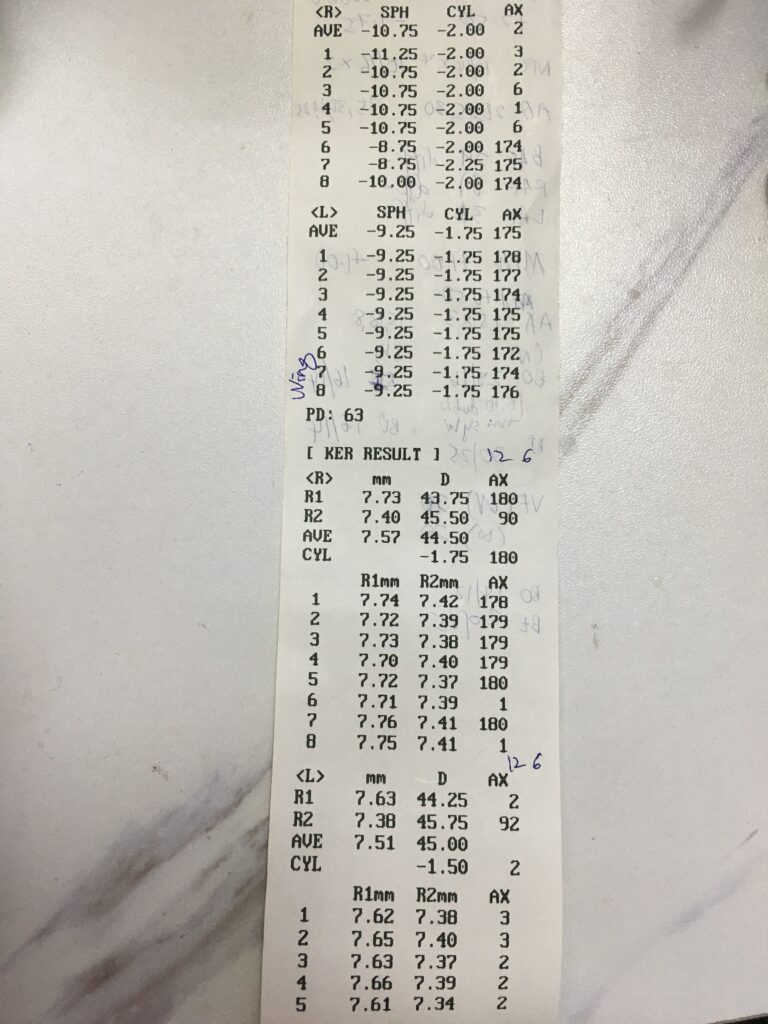18/4/2021
Wing (M/13) came back for follow up after 1+year, complaining of slight blurry far vision & headache after coming back from school. He needs to push his glasses closer to eyes in order to copy from whiteboard.
Vision with existing glasses
R: -9.00/-1.50×180 (6/9-)
L: -8.50/-1.75×180 (6/6)
Examination shows:
R: -9.50/-1.50×180 (6/6)
L: -8.25/-1.75×180 (6/6)
Relax Add: +1.50
Other assessments show:
Examination of Eye Alignment/Vergence (Cover Test)
NMD @Distance & Near
(normal value: orthophoria/NMD-No Movement Detected or small XP fast recovery)
EP = Esophoria is misalignment of the eye, eye is deviated inwards
XP = Exophoria is misalignment of the eye, eye is deviated outwards
NRA (accommodation analysis – ability to relax accommodation)
+2.00 (normal value: +1.50 to +2.50)
PRA (accommodation analysis – ability to stimulate accommodation)
-1.25 (normal value: -1.37 to -3.37)
Facility (Accommodation facility – ability to change focus: far to near or near to far) by Flipper +/- 2.00
R: 11 cycle per minit(cpm)
L: 9 cycle per minit(cpm) difficult with minus lens
BE: 10 cycle per minit(cpm)
(normal value:
Monocular or R/L: 6cpm to 16cpm
Binocular or BE-both eyes: 4cpm to 14cpm)
Wing’s shortsighted power/myopia has increased 050 in right eye. Progression of more than 075 is considered a red flag, so he is on the borderline. At his age, he has many more years of schooling to go.. and his power is extremely high. We strongly advise to take on myopia control, not only would we want to let him see clear & comfortably, but we also want to control the progression of his shortsighted power.. while we still can, as we expect increased near work during schooling or eye growth bring about power progression.
Wing has pretty good Accommodation & Vergence. We reinforce proper visual hygiene by:
- taking regular break 20-20-20 rule in between near work,
- to hold phone/reading material at Harmon distance,
- to always have enough lighting for our eyes to see, and
- to have a proper posture to see as well
Mother opts for spectacle lenses in myopia control. We prescribe myopia control spectacle lenses for Wing and have him to come back in 4-6weeks after fulltime wear of the new glasses and subsequently every 3months follow up for close monitoring. Despite having myopia control lenses, proper visual hygiene still goes hand in hand in controlling myopia.
20/10/2021
*UpdatedA
Wing came back 6 months later. Due to his extremely high myopia, we are very concerned about his myopia progression.
Vision with habitual glasses:
R: -9.50/-1.50×180 (6/6)
L: -8.25/-1.75×180 (6/6)
Add: +1.50
Other assessments show: (with habitual glasses)
Examination of Eye Alignment/Vergence (Cover Test)
NMD @ Distance
NMD @ Near
(normal value: orthophoria/NMD-No Movement Detected or small XP fast recovery)
EP = Esophoria is misalignment of the eye, eye is deviated inwards
XP = Exophoria is misalignment of the eye, eye is deviated outwards
Examination of Eye Alignment/Posture (Howell Card) by 6^ Base Down on Right eye
Distance: 0
Near: 4 – 6 XP (blue part)
(normal value: 0-1 EP or 0-3 XP @Distance and 0-6 XP @Near)
EP = Esophoria is misalignment of the eye, eye is deviated inwards
XP = Exophoria is misalignment of the eye, eye is deviated outwards
NRA (accommodation analysis – ability to relax accommodation)
+1.50
(normal value: +1.50 to +2.50)
PRA (accommodation analysis – ability to stimulate accommodation)
-1.75
(normal value: -1.37 to -3.37)
MEM (Accommodation lag – to measure accommodation response seeing near target)
R: +0.50
L: +0.50
(normal value: +0.25 to +0.75)
Facility (Accommodation facility – ability to change focus: far to near or near to far) by Flipper +/- 2.00
R: 11 cycle per minit(cpm)
L: 11 cycle per minit(cpm)
BE: 10 cycle per minit(cpm)
(normal value:
Monocular or R/L: 6cpm to 16cpm
Binocular or BE-both eyes: 4cpm to 14cpm)
Examination of Fusional Reserves (Convergent/Divergent reserve stamina) by Prism Bar
Near, Base-Out/Convergent, PFV: 25/45/40
Near, Base-In/Divergent, NFV: 18/30/20
(normal value: Blur/Break/Recovery)
Near, PFV: 16/15-31/10-22
Near, NFV: 13/7-17/3-11
[Scheiman et al, 1989]
*UpdatedB
Wing (M/14) came back for follow up. Vision with his existing glasses is fine seeing far & near. He is able to copy from whiteboard at school. No headache is reported. We observe that he holds his phone very close.
Vision without glasses
R: guess 6/120
L: guess 6/120
Vision with existing glasses
R: -9.50/-1.50×180 (6/6-)
L: -8.25/-1.75×180 (6/6-)
Add: +1.50
Subjective Refraction
R: -9.75/-1.00×180 (6/6) (+1.00 blur lens test: 6/12)
L: -8.50/-1.25×180 (6/6) (+1.00 blur lens test: 6/12)
Lower DC is not favoured @N
Other assessments show:
Cover Test
Distance: NMD
(upon ACT: pt reported RE sees smaller, LE sees bigger)
Near: NMD
Howell Card
Distance: 0
Near: 2 – 4 XP
+1.00 Near: 10 – 12 XP
-1.00 Near: 4 XP
+2.00 Near: 12 XP
-2.00 Near: 0
NRA
+2.50
PRA
-1.75
NPC
10/14cm, 10/14cm, 10/14cm, 10/16cm, 10/16cm, 10/16cm
AA
R: 11.5D, 10.5D, 9.5D
L: 13.5D, 12.5D, 12.5D
MEM
R: +1.00
L: +1.00
AA (with Add +0.50)
R: 13.5D, 13.5D, 13.5D
L: 13.5D, 12.5D, 12.5D
Accommodation Facility (+/- 2.00)
BE: 14 cpm, difficult minus lens
R: 15 cpm, difficult minus lens
L: 15 cpm, difficult minus lens
Fusional Reserves
Near, PFV: x/25/16 (break pt 8 & 10.. double then single)
Near, NFV: x/30/25
Distance, NFV: x/16/14
Distance, PFV: x/16/14
Vergence Facility
Near: 10 cpm
Distance: 10 cpm
Fusional Reserves (with Add +0.50)
Near, PFV: x/14/12 (break pt 8 & 10.. double then single)
Near, NFV: x/30/25
Interpupillary distance, IPD = 6.3cm
Acceptance
R: -9.75/-1.00×180
L: -8.50/-1.25×180
Add: +0.50
(higher Add xfavoured)
JWing will continue with his existing glasses.


